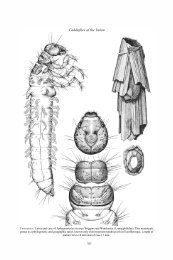Spiders of the Yukon - Department of Biological Sciences
Spiders of the Yukon - Department of Biological Sciences
Spiders of the Yukon - Department of Biological Sciences
You also want an ePaper? Increase the reach of your titles
YUMPU automatically turns print PDFs into web optimized ePapers that Google loves.
110 C.D. Dondale et al.<br />
The remaining 72 Boreal species are all widespread in <strong>the</strong> Nearctic only (Table 1). They<br />
inhabit coniferous foliage or moss and litter beneath <strong>the</strong> conifers <strong>of</strong> <strong>the</strong> boreal forest. Some<br />
well-known representatives <strong>of</strong> this group are Argenna obesa (2), Theridion montanum (23),<br />
Bathyphantes pallidus (37), Ceraticelus atriceps (67), Grammonota angusta (96), Hypselistes<br />
florens (111), Araneus corticarius (167), Tetragnatha versicolor (183), Hogna frondicola<br />
(196), Pardosa moesta (207), and Eris militaris (285).<br />
Unassigned Species. Here we place 11 species that are not readily assignable to any <strong>of</strong> <strong>the</strong><br />
3 zones used in this work. Nine <strong>of</strong> <strong>the</strong>m are widespread west <strong>of</strong> Hudson Bay and extend<br />
southward in <strong>the</strong> Cordillera as well as into <strong>the</strong> Central Plains. The wolf spider Schizocosa<br />
minnesotensis (219) occurs on sagebrush slopes in Kluane National Park, but <strong>the</strong> o<strong>the</strong>r<br />
8 appear to be generalized litter inhabitants. The remaining pair <strong>of</strong> unassigned species are<br />
known from a few specimens collected in <strong>the</strong> Matanuska Valley <strong>of</strong> Alaska and from <strong>the</strong><br />
sou<strong>the</strong>rn <strong>Yukon</strong>; <strong>the</strong>y are <strong>the</strong> erigonids “Erigone” matanuskae (90) and Scotinotylus<br />
bodenburgi (136).<br />
Conclusions. Our compilation and preliminary analysis <strong>of</strong> <strong>the</strong> spiders <strong>of</strong> <strong>the</strong> <strong>Yukon</strong><br />
constitute only a first step toward understanding <strong>the</strong> <strong>Yukon</strong> spider fauna. As <strong>the</strong> 39<br />
“probable” species indicate, <strong>the</strong> list is far from complete, and much careful and thorough<br />
collecting is needed to reveal <strong>the</strong> full extent <strong>of</strong> this part <strong>of</strong> <strong>the</strong> nor<strong>the</strong>rn fauna. A second major<br />
barrier to understanding is found in our ability to judge <strong>the</strong> distinctness and limits <strong>of</strong> <strong>the</strong><br />
nor<strong>the</strong>rn species. Till now <strong>the</strong> many <strong>Yukon</strong> species thought to be uniform populations, even<br />
though spread over vast areas <strong>of</strong> <strong>the</strong> Nearctic, or <strong>of</strong> <strong>the</strong> Holarctic, have been treated as units<br />
on <strong>the</strong> basis <strong>of</strong> preserved specimens. At least some <strong>of</strong> <strong>the</strong>m would probably pr<strong>of</strong>it from<br />
examination by behavioural, electrophoretic, or o<strong>the</strong>r means using live material. Two minor<br />
works that tend toward this approach are those dealing with Philodromus rufus (274) and<br />
Pardosa fuscula (201). In each case, workers had treated <strong>the</strong> species as widespread in <strong>the</strong><br />
Holarctic, whereas behavioural and o<strong>the</strong>r data suggested <strong>the</strong> presence <strong>of</strong> a number <strong>of</strong><br />
subspecies (species?) <strong>of</strong> P. rufus and two distinguishable species, P. fuscula in <strong>the</strong> Nearctic<br />
and P. atrata (Thorell) in <strong>the</strong> Palaearctic, in Pardosa. In both cases, <strong>the</strong> Bering Strait<br />
apparently forms a barrier to species continuity.<br />
The strictly Beringian species cited here may, on <strong>the</strong> o<strong>the</strong>r hand, constitute single genetic<br />
units regardless <strong>of</strong> <strong>the</strong>ir separation into two geographic parts by <strong>the</strong> intervention <strong>of</strong> Bering<br />
Strait. This similarity can be attributed to <strong>the</strong> long period <strong>of</strong> time between <strong>the</strong> Miocene and<br />
<strong>the</strong> Pleistocene during which <strong>the</strong> Bering land connection remained intact. There may, <strong>of</strong><br />
course, have been warm intervals during this period which allowed flooding <strong>of</strong> <strong>the</strong> land<br />
bridge in part or in whole. This is yet ano<strong>the</strong>r possible factor to be considered in <strong>the</strong> search<br />
for understanding <strong>of</strong> <strong>the</strong> <strong>Yukon</strong> spider fauna.<br />
References<br />
Aitchison-Benell, C.W. and C.D. Dondale. 1990. A check list <strong>of</strong> Manitoba spiders (Araneae) with notes on<br />
geographic relationships. Naturaliste can. 117:215 – 237.<br />
Braendegaard, J. 1946. The spiders (Araneina) <strong>of</strong> east Greenland. Meddr Grønland 121:1 –128.<br />
______ 1958. Araneida. pp. 1-113 in H. Einarsson (Ed.), The Zoology <strong>of</strong> Iceland. Vol. 3, Part 54. E. Munksgaard,<br />
Copenhagen. 113 pp.<br />
Chamberlin, R.V. and W. Ivie. 1947. The spiders <strong>of</strong> Alaska. Bull. Univ. Utah biol. Ser. 37(10). 103 pp.<br />
Crawford, R.L. 1988. An annotated checklist <strong>of</strong> <strong>the</strong> spiders <strong>of</strong> Washington. Burke Mus. Contrib. Anthrop. nat. Hist.<br />
5. 48 pp.<br />
Cutler, B. 1990. A revision <strong>of</strong> <strong>the</strong> western hemisphere Chalcoscirtus (Araneae: Salticidae). Bull. Br. arachnol. Soc.<br />
8:105 –108.

















